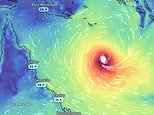Major update on Cyclone Jasper – as panic buying rocks supermarkets and cruise ships are turned away in Queensland

Residents in affected areas should prepare for a cyclone as soon as the first warnings appear.
Make an emergency kit and plan
Your emergency kit should include everything your household needs to survive without access to power and clean water for several days.
This should include the following:
- Enough water for three days: about 10 liters per person
- Enough non-perishable food for three days and cutlery, a can opener and plates
- Cooking equipment – portable stove and fuel
- Self-powered items including a radio, flashlights, portable charger
- First aid kit
- Essential medicines
- Warm and protective clothing
- Toiletries
- Important documents (sealed in plastic bags)
- Cash
- Bedding
- Pet Supplies
- Extra batteries
Your household should also have an emergency plan in place and know how to shut off the main water, electricity and gas supplies.
Your plan should include which local shelter you will go to if necessary, the best route from your home to the shelter, what you will leave behind in an emergency, what room you will shelter in, and how you will stay in touch with friends and family. family.
QFES also recommends that you fill your vehicle with fuel and park it in a sheltered area in case you need to evacuate.
Check your property
Properties in the line of fire of a cyclone must be cleared of projectiles that cause injury or damage.
QFES recommends clearing your gutters and downspouts, removing shade sails, moving caravans and boats to a covered area or securely anchoring them to the ground and pruning dangerous trees.
All outdoor furniture, including trampolines and garden pots, should be moved indoors or tied down.
Homeowners should also check that window and door seals are in good condition.
Check your neighborhood
Contact your municipality or energy supplier if you see trees in your street that could fall and damage houses or power lines.
DAY OF THE CYCLONE
On days when the cyclone is expected to hit your area, the QFES advises that you closely monitor local warnings.
Households must also:
- Fill emergency containers with drinking water
- Close all windows and consider taping plastic sheeting on the inside to prevent wind-driven rain
- Make sure everyone and all pets are in the house
- The emergency double check kit is ready
QFES is also encouraging residents to check in with friends and loved ones to ensure they are also prepared for the cyclone.
DURING THE CYCLONE
QFES is urging everyone in cyclone-affected areas to listen and adhere to local warnings shared on radio and television.
If you are asked to evacuate, go to the nearest municipal shelter.
“Emergency services or municipal staff can visit your area to issue warnings,” QFES said.
'If a warning is issued, make sure everyone in your home is aware of the warning and advice.'
During a cyclone, all members of your household should wear closed-toe shoes and sturdy clothing for protection.
All electricity, gas and water in the home must be turned off at the main connection.
If your home is hit by a cyclone and you have not evacuated, QFES advises you to:
- Go to the shelter listed in your emergency plan
- Keep up to date with local information via a radio
- Stay in your home until authorities tell you it is safe to leave
If your home is damaged during the storm, QFES recommends hiding under a strong table, sofa or heavy mattress.
“If you are driving when the cyclone hits, stop the vehicle and apply the handbrake,” QFES said.
'Stop far away from the sea and away from trees, power lines and streams.
“Stay in the vehicle.”
AFTER THE CYCLONE
Do not venture outside your shelter until authorities advise it is safe to do so. The eye of cyclones may appear calm before dangerous conditions develop again.
QFES recommends contacting family and friends once the storms pass.
If you are returning home from an evacuation shelter, follow the route recommended by emergency services and avoid driving through flood water, even if it appears shallow.
Inspect and photograph any damage to your property for insurance purposes.
